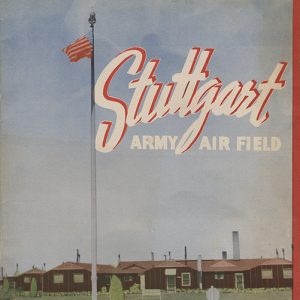calsfoundation@cals.org
Stuttgart Army Air Field
The United States Army Air Forces (USAAF) opened the Stuttgart Army Airfield in October 1942. The airfield was located in Prairie County on approximately 2,682 acres about seven miles north of Stuttgart (Arkansas County).
The facility consisted of four 5,000-foot runways and facilities for 6,000 personnel. The USAAF trained pilots in the use of gliders from October 1942 to May 1943. This was the second, or advanced, phase of their training, and they learned to fly the WACO CG-4A “Hadrian.” This glider had plywood-covered wings that spanned eighty-three feet and a fabric-covered tube-structure fuselage that was forty-eight feet long. It could carry about thirteen men, or six men and a Jeep, or various other combinations, including ammo, supplies, and weapons. It weighed 4,500 pounds empty and had a maximum payload of 1.5 tons.
From May 1943 to December 1944, the airfield was used to train pilots in the operation of twin-engine planes. There were also Women Airforce Service Pilots (WASPs) stationed at Stuttgart. The WASPs flew the twin-engine Beech AT-10 “Wichita,” the single-engine AT-6 “Texan,” the twin-engine Cessna UC-78 “Bobcat,” and the single-engine Noorduyn UC-64 “Norseman” as engineering/test pilots, ferrying pilots, and administrative/courier pilots.
The airfield also hosted a prisoner-of-war camp for both German and Italian soldiers who had been captured. The POWs helped nearby farmers work their land.
The airfield was deactivated in December 1944. The Department of War declared the airfield excess in August 1946, and the entire site was eventually deeded to the City of Stuttgart.
In 1959, a three-mile Sports Car Club of America road course was designed on the site, using the airfield’s runways and aprons. Races were held annually until 1978. The Stuttgart Dragway also operated in the site from 1970 to 1972.
The airfield is the site of the Stuttgart Municipal Airport (SGT) as well as an industrial park and a National Guard Armory.
For additional information:
“Many Gliders in Air Today,” Daily Leader and Arkansawyer, October 12, 1942, p. 1.
Mosenthin, H. Glenn. “Stuttgart Army Airfield: A Photo Essay.” Grand Prairie Historical Bulletin 58 (April 2015): 38–43.
Munger, Makena F. “‘See You at the Flight Line’: The Stuttgart Army Air Field.” Grand Prairie Historical Bulletin 68 (April 2025): 2–11.
“SAAF To Be Air Technical Service Command,” Daily Leader and Arkansawyer, December, 19, 1944, p. 1.
“Stuttgart Army Airfield.” UNXOInfo.com. http://www.uxoinfo.com/uxoinfo/sitedata1.cfm?siteno=38 (accessed April 27, 2022).
Stuttgart Army Air Field Collection. Butler Center for Arkansas Studies. Central Arkansas Library System, Little Rock, Arkansas. Finding aid online at http://purl.oclc.org/arstudies/bc-mss-1212 (accessed April 27, 2022).
Steve Rucker
Little Rock, Arkansas








My grandfather Colonel Edgar R. Todd was the commanding officer for Stuttgart Army Airfield from initial construction until his death in 1943 from a training accident.
My 91-year-old neighbor was born in Stuttgart and said when she walked to school, she saw and talked to the German prisoners working in the rice fields.